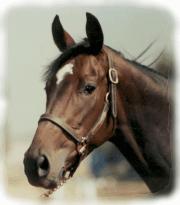
A Horse, of Course with Don Blazer |
If you enjoy learning about horses, then you'll love our online courses. Each month you'll find a new column on our web site. We hope you'll enjoy it, and maybe e-mail us with questions or suggestions for other columns. A Horse, Of Course is a monthly column syndicated by Success Is Easy. If you like the column, call your local newspaper, or local horse publication and ask them to subscribe by contacting Success Is Easy. |
The Forward Seat Don Blazer copyright©2015 |

If you ride jumpers
and you want to be good, don’t jump to any conclusions. Frederico Caprilli (1868-1907) had a few things to say about jumpers and saddles and position. Caprilli said to understand a jumping horse, watch a riderless horse jumping. (That’s clever, and something a lot of riding instructors should do, but apparently don’t.) That sly Italian said, “The principal lesson to be learned is that the rider should be at pains to allow the horse to jump with his natural movement.” Sounds exactly like the fourth secret of perfect horsemanship: give, let go, free the horse; in order to be victorious in horsemanship, the rider must surrender. Having watched a lot of riderless horses jump, Caprilli developed a new theory, then a new rider position, and finally a new saddle: The Forward Seat. The forward seat changed the rider’s position when approaching the jump from straight up to a slight forward incline, but “without exaggeration.” And it left the rider slightly inclined while the horse was landing, rather than at an exaggerated incline backward as was the habit of the day. Caprilli never said “bend at the waist and throw your head and shoulders down toward the horse’s neck and off to the side.” This practitioner of his own new theory said, “…to signal to the horse when he is to jump, as some people advocate, is extremely difficult, and even if perfectly timed, does as a rule more harm than good…” In perfect horsemanship the rider asks – in the case of a jumper by showing the horse what is to be jumped – and the horse performs. Horses perform best when the rider interferes the least. Caprilli said a capable jumper should not be interfered with, because the good horse will “measure his obstacle” and will decide on his own “the strength he needs to clear it without the rider requiring to add any more.” The mediocre jumper, Caprilli said, can only be improved by rational and continuous practice and not through the aids, or violent and sudden means.” That’s a little tough on mankind’s ego. What Caprilli disapproved of most was the takeover of a good horse by a rider. “A horse schooled on my principles knows enough, when jumping, to realize that he is about to need extra energy and therefore acts accordingly. Any interference on the part of the rider can only be harmful.” Caprilli was against “spot” jumping, and the attempts of a rider to “put in” an extra stride, or “stretch out” a stride. The Italian didn’t want his riders determining the point of take-off; he wanted the horse to make that determination. He said, “I would like someone to quote a single case in which it would have been better that the horse be less free.” Furthermore, he said, “If a horse’s head is free he will look where he puts his feet. Scatter a few stones on the landing side and notice how cleverly he will avoid them.” Caprilli wrote it all down so wise riders could learn from the experience of others. Funny, isn’t it, Xenophon, a Greek, also wrote much the same thing about 2,300 years earlier. And today, the same ideas are being written again in a slightly different way. It is a wise man who learns from experience, and a wiser man still who learns from the experience of others. I don’t know who said that. I just know while it was a pretty clever thing to say, unfortunately a lot of people aren’t learning from it. It seems they are jumping to the conclusion they can’t learn a lot of horsemanship from books. If that’s true they are going to continue crashing into a lot of jumps. * Earn a degree in equine studies, or certification as a horse trainer, riding instructor or stable manager. Go to www.horsecoursesonline.com for more information. |